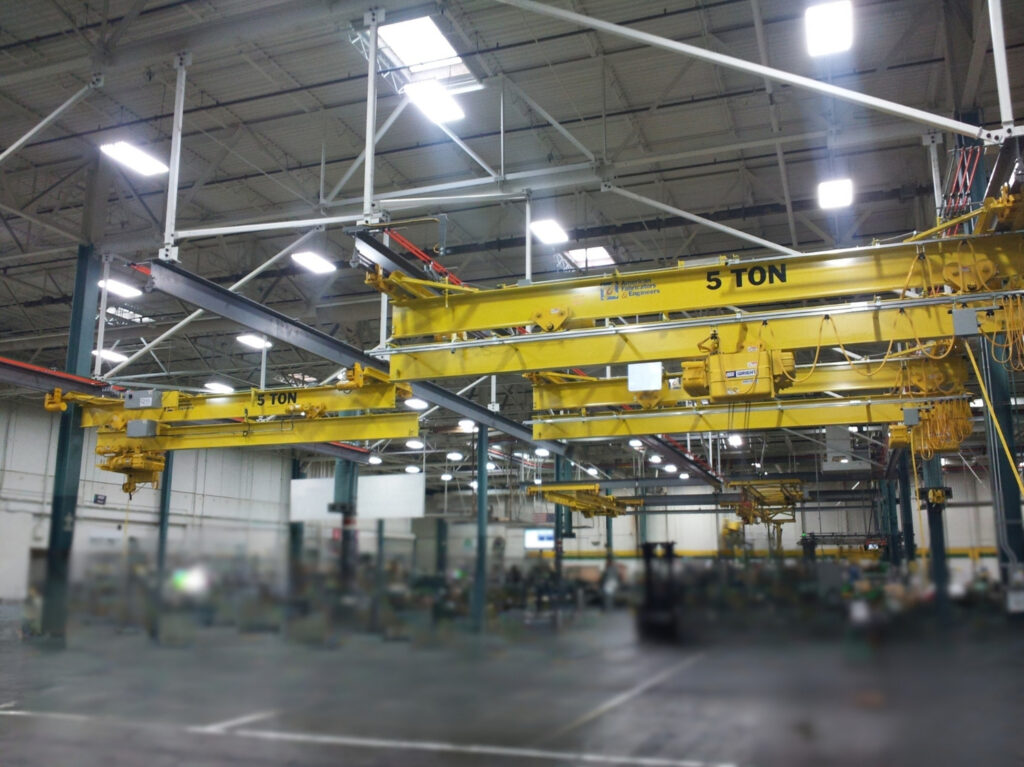Call us today at (800) 728-0818
Telescoping bridge cranes, also known as projecting bridge cranes, are underhung overhead cranes with a secondary bridge that extends beyond the end of the main bridge beam. This design allows the crane to reach into adjacent bays or around structural columns, then retract to pass through standard runways.
Telescoping bridge cranes, also known as projecting bridge cranes, are underhung overhead cranes with a secondary bridge that extends beyond the end of the main bridge beam. This design allows the crane to reach into adjacent bays or around structural columns, then retract to pass through standard runways.
AFE Crane offers telescoping bridge cranes as an economical way to extend hook coverage without altering your facility’s structure. These cranes are ideal for accessing hard-to-reach areas—such as behind columns or into neighboring bays—where traditional bridge cranes fall short. Typically projecting in one direction, they can also be engineered to project in both directions for maximum flexibility.
Telescoping bridge cranes are available in both underhung single girder and double girder configurations, and can be equipped with collision avoidance technology to help prevent contact with building columns or nearby equipment. This makes them a practical choice for increasing reach and maintaining safety in complex or space-restricted environments.
AFE Crane offers telescoping bridge cranes as an economical way to extend hook coverage without altering your facility’s structure. These cranes are ideal for accessing hard-to-reach areas—such as behind columns or into neighboring bays—where traditional bridge cranes fall short. Typically projecting in one direction, they can also be engineered to project in both directions for maximum flexibility.
Telescoping bridge cranes are available in both underhung single girder and double girder configurations, and can be equipped with collision avoidance technology to help prevent contact with building columns or nearby equipment. This makes them a practical choice for increasing reach and maintaining safety in complex or space-restricted environments.
AFE Crane offers two types of telescoping cranes designed for optimal efficiency in confined or restricted spaces: Underhung Single Girder Telescoping Cranes and Underhung Double Girder Telescoping Cranes.

Single girder telescoping cranes are ideal for lighter capacities and simpler applications. Their streamlined design enables smooth and precise movement, making them a cost-effective solution for facilities with lower weight capacities.
Both crane types are underhung, allowing them to run directly on the lower flange of a runway beam. This design eliminates the need for floor space, making telescoping cranes perfect for environments with space constraints or obstacles. Contact us to learn which telescoping crane fits your needs!

Telescoping cranes offer unique advantages for facilities with space constraints, complex layouts, or specialized lifting requirements. A well-designed system not only maximizes efficiency but also improves safety and longevity. We offer fully customizable telescoping cranes to meet your exact needs, whether for hazardous environments, low headroom applications, or advanced automation.
Explosion-proof components, corrosion-resistant materials, and sealed electrical systems for extreme conditions.
Optimized beam profiles, compact hoist integration, and custom travel limits for tight spaces.
Proximity sensors, automated stop functions, and warning systems to prevent damage to near by equipment or building columns.
Radio remotes, VFDs for smooth movement, and automated positioning for precision.
Real-time load cells, programmable limits, and wireless diagnostics to enhance safety.
Magnetic, vacuum, and below-the-hook lifting solutions designed per ASME BTH-1 and B30.20.
Custom runway systems, synchronized operations, and turnkey installation for seamless setup.
If you don’t see the customization you’re looking for, AFE Crane can design a solution to fit your specific needs. Contact us to discuss your requirements.
AFE utilizes a large comprehensive supply chain for materials and parts in addition to establishing long term relationships with our parts vendors. This relationship helps us to expedite parts so that your equipment can be repaired quickly.

This file category has no files to display
What Are Telescoping (or Projecting) Bridge Cranes? Telescoping bridge cranes, also known as projecting bridge cranes, are a specialized type of underhung bridge crane designed
Improving efficiency and safety in material handling is essential for staying competitive in today’s market. AFE Crane offers automation and smart crane technologies to help
A telescoping crane features a boom that can extend and retract, allowing it to reach different lengths for flexible lifting solutions.
Yes, telescoping cranes are available in both electric-powered and manually operated models.
Telescoping cranes include safety features such as limit switches to automatically retract the hoist and then the telescoping beam, ensuring proper retraction sequencing. Optional anti-collision technology is available to help navigate around building columns or machinery. Additionally, optional programming can be implemented to prevent the bridge crane from moving while the telescoping beam is projected, enhancing operational safety.